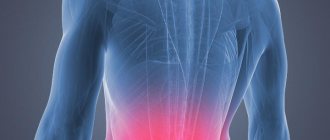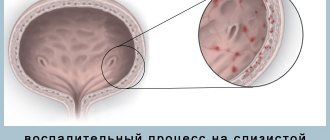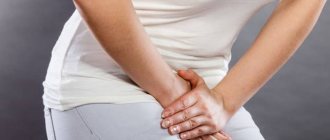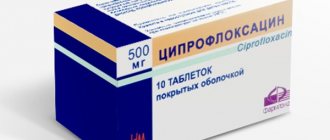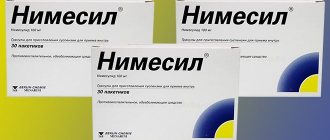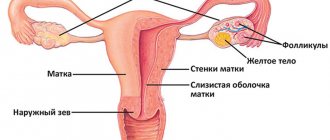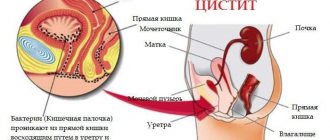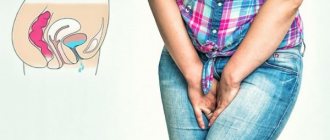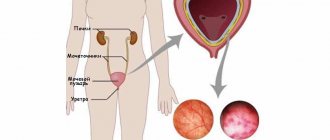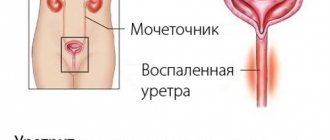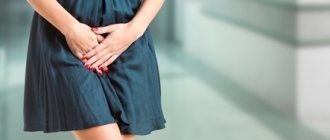Cystitis is an inflammatory process in the body that is localized in the bladder area. Most often, this pathology is diagnosed in representatives of the fair sex, who by nature have wide and short ureters, through which pathogenic microflora easily enters the body. Drug therapy is used to treat this disease. But in order to achieve a pronounced therapeutic effect, it is necessary to use an integrated approach. Physiotherapy for cystitis is a proven and safe method that helps get rid of the symptoms of urinary inflammation.
Physiotherapy methods for cystitis
To speed up recovery, it is important to eliminate the possibility of congestion. For this purpose, procedures are prescribed that accelerate the outflow of fluids. They are gentler and can be used at home.
With amplipulse therapy, the body is exposed to sinusoidal modulated currents.
Amplipulsetherapy
In this case, the body is affected by sinusoidal modulated currents. During therapy the following effects are achieved:
- anesthetic;
- neurostimulating;
- trophic;
- vasodilator.
Under the influence of electrotherapy, soft tissues and vessel walls relax, swelling is eliminated, and metabolic processes are accelerated. Additionally, the outflow of fluid from the body increases. To achieve the desired result, 7 sessions are performed.
Sitz baths
It is recommended to use sodium chloride and iodine-bromine compounds. Radon baths are also useful. This technique is used as an auxiliary measure in the treatment of inflammatory processes in the bladder.
[morkovin_vg video=”DbhdK9w_gms;N7Dw5eM_rWk;sULkhO5iqq8"]
For cystitis, it is recommended to drink sulfate, chloride, and low-mineral waters. The technique promotes recovery by providing the body with a sufficient amount of nutrients. In addition, mineral waters of some compositions are characterized by a diuretic effect. In case of kidney disease, this technique is used with caution, since the process of passing stones may begin.
Sitz baths
Physiotherapy. Electrophoresis.
EHF Therapy
cystitis treatment
Any treatment method has its advantages and disadvantages. Physiotherapy sessions are no exception to this rule. The appointment of one of the methods occurs as directed by the urologist involved in the treatment.
Direct indications for physiotherapy for cystitis:
- Chronic forms of the disease - prolonged inflammation is fraught with the formation of pathological irreversible changes in the mucosa: scars, scars, replacement of functional tissue with connective tissue. Taking medications does not have the desired effect. For chronic cystitis, physiotherapy is indicated that enhances the medicinal effect of drugs, relieves the inflammatory process and promotes rapid recovery of the patient.
- For cystitis in children, physical treatment is necessary to strengthen local immunity and the ability to resist infections. The benefits of the sessions are associated with a mild diuretic effect, have a relaxing and analgesic effect and help to do without analgesics and antispasmodics, or at least limit their use, reducing the negative impact of drug therapy for the child.
- Physiotherapy for female cystitis - relieves inflammation, replaces the use of muscle relaxants and diuretics. Before prescribing, it is necessary to undergo a thorough examination in order to exclude contraindications: inflammatory processes of the reproductive organs and pregnancy.
- For cystitis in men, due to the anatomical features of the body, prescribed symptomatic medications often turn out to be ineffective and are unable to relieve pain during an exacerbation of the disease. Physiotherapy of the bladder is especially necessary for inflammation, aggravated by the development of related diseases and disorders in the genitourinary system.
Despite the obvious benefits, physical therapy is prohibited:
- with acute cystitis, accompanied by a strong increase in temperature;
- inflammation caused by malignant tumor processes;
- tendency to bleed;
- hemorrhagic and purulent cystitis;
- psychoemotional disorders, schizophrenia, epilepsy;
- early stages of pregnancy.
The urologist will select the most appropriate method of physical treatment and determine the presence of contraindications. Sessions are prescribed during the period of completion of antibacterial therapy, during acute processes provoked by a non-infectious factor, and also as preventive measures to prevent relapse of the disease.
The methods differ in the principle of influence and therapeutic effect. When choosing an appropriate physiotherapy treatment for cystitis, the urologist will take into account the presence of the following manifestations of the disease:
- pain syndrome;
- urinary disorders;
- insufficient effect of medications taken due to extensive congestion;
- malfunctions of the immune system.
Physiotherapeutic procedures for cystitis are selected individually. The prescription is influenced by contraindications, as well as intolerance to the method, possible complications and allergic reactions are taken into account.
The technique is based on the use of a magnetic field of various frequencies when affecting the affected organ. The results become obvious after completing the full course of treatment, lasting 10-15 days.
With magnetophoresis, an additional healing effect is provided by the introduction of medications during the session. There is no need for injections or instillations. Medicines in the form of a suspension are administered using a generated magnetic field. For cystitis, the physiotherapy device is alternately placed on points in the area of the suprapubic bone and the lumbar region.
The benefit of the method is the rapid disinfection of inflamed tissues. During the sessions, the destruction of viruses, bacteria and toxins (products of the activity of pathogenic microflora) is observed. The use of magnetic therapy to treat cystitis is equally effective for men, women and children. Sessions are conducted exclusively in a clinical setting.
The principle of action is based on the administration and transportation of drugs to the site of inflammation. During the session, an electric current is used, provoking the release of ions moving in the direction specified by the device. The drug delivered to the tissue promotes the disintegration of positively and negatively charged particles that have fulfilled their purpose.
Electrophoresis is one of the most effective methods of physiotherapy for chronic inflammatory process. After the first session, the following improvements are observed:
- swelling will go away;
- stimulates rapid regeneration and restoration of damaged tissues;
- metabolic processes are normalized;
- congestion is eliminated;
- micromassage of tissues is performed to increase blood flow.
The electrophoresis technique is effective in 70% of cases. When using sessions to prevent seasonal exacerbations, it is possible to reduce the frequency of relapses to 1-2 per year, or completely get rid of the disease.
Medicines used for electrophoresis: lidase, aminophylline, methenamine and penicillin. If inflammation has spread to the reproductive organs and caused complications, physiotherapy with zinc is performed. Zinc effectively fights chronic processes and diseases in an advanced stage.
The method is in many ways similar to electrophoresis. Under the influence of low voltage current on an area of the body, the structure of cell membranes changes and the permeability of the skin increases. At the same time, there is an activation of metabolic processes and regeneration. During iontophoresis, two electrodes with different poles are installed. An electromagnetic field is created between the sensors, which leads to increased blood flow and accelerated lymphatic drainage.
Physiotherapy is not only about applying current to an area of the body. The activation of ions that transport drugs into deep tissues is provoked. Medicines can penetrate into tissues that tablet medications cannot reach.
In this case, the source of inflammation is affected using UHF rays. The intensity of irradiation is selected individually. Ultrasound therapy is considered the gold standard for the treatment of any inflammatory processes of the genitourinary system. The method has a beneficial effect in three main areas:
- Destroys infectious agents - physiotherapy does not replace antibacterial therapy, but kills residual microflora, helping to achieve stable remission of cystitis.
- Relieves the inflammatory process.
- Improves blood flow in the organs of the genitourinary system - absence of stagnation, good blood circulation, these are necessary conditions for preventing frequent relapses of the disease and strengthening local immunity.
Ultrasound treatment is popular for another reason. There are medications for use at home. Domestic developments: Vitafon, Biomed, Reton Out, foreign: Soleo, Clarisonic, Sonostat, etc.
Before starting physical therapy, you should make sure that there are no contraindications and find out about possible complications when using UHF. A side effect of ultrasound treatment is an increase in the therapeutic effect of certain hormonal drugs, which provokes a severe allergic reaction. UHF should absolutely not be combined with hydrocortisone.
Leeches are traditionally used in the fight against inflammatory processes and congestion in the genitourinary system. As a rule, hirudotherapy is prescribed in combination with other physical treatment methods.
Operating principle: something between acupuncture and acupressure. Leeches are placed on biologically active points. When feeding on this subspecies of annelids, there is a therapeutic effect associated with the following:
- rotten, stagnant blood is removed;
- when bitten, an enzyme is injected into the wound, diluting the plasma, eliminating blood clots;
- leech saliva contains elements that relieve pain and relieve inflammation;
- lymphatic drainage effects lead to easier urination.
Hirudotherapy helps with cystitis only if the treatment is carried out correctly. A special subspecies of leeches is used, they are placed in certain, biologically active points. The method is prohibited for patients with diseases and poor blood clotting, as well as women during the menstrual cycle.
Treatment is carried out in several ways. The basic principle involves applying heat to the inflamed area of the body. Therapy is indispensable for chronic, low-grade forms of inflammation. Methods of therapeutic heating:
- Hyperthermia - heating of tissues is carried out through radiation or chemotherapy. After several sessions, increased blood flow to the damaged organ is observed, pathogenic microorganisms are destroyed, and inflammation is reduced. The method is not suitable for the treatment of radiation and chemical cystitis.
- Applications - heating a body area is carried out by applying wax bandages. Dry heat has a beneficial effect on fabrics. The body's response to an increase in temperature: activation of local immunity to fight infection, reduction of the inflammatory process and elimination of pain.
Antibacterial treatment
Antibacterial treatment should comply with the following principles:
- the course of treatment should not exceed 7-10 days;
- when prescribing the drug, they are guided by the results of studies to identify the strain of the pathogenic microorganism and the degree of exposure to antibiotics;
- preference is given to drugs with bactericidal properties.
The duration of the course of antibacterial therapy is due to the fact that the treatment of chronic cystitis can be complicated by the localization of the pathogen in the submucosal layer of the bladder.
The most common prescriptions are drugs from the fluoroquinolone group:
- Ciprofloxacin;
- Gatifloxacin;
- Norfloxacin;
- Ofloxacin;
- Lomefloxacin.
The medications affect most gram-negative bacteria that cause urological infections. Modern pharmacology has created a new type of drugs that need to be taken only once a day. Their feature is the gradual release of, for example, ciprofloxacin, like Ificipro OD.
If sexually transmitted infections are detected, antibacterial drugs of the following groups are prescribed:
- macrolides - new generation antibiotics (Erythromycin, Roxithromycin, Eriderm, Sumamed, Azitrox, Zinerid, Vilprafen, Midekamicin, Kitazemycin), act against many sexually transmitted infections;
- tetracyclines (Doxycycline, Minocycline, Hyoxizone, Oxycyclosol);
- fluoroquinolones (Perfloxacin, Ciprofloxacin, Fleroxacin, Temafloxacin, Sparfloxacin).
All of these antibiotics contribute to the eradication of pathogenic microorganisms with subsequent normalization of the microflora.
Goals and effectiveness
Physiotherapy for cystitis in women and men can be part of therapy when it is necessary to help normalize intracellular processes, which subsequently reduces the intensity of external signs. Performing procedures provides different effects:
- the development of inflammation stops;
- the spasm is eliminated, and at the same time the pain goes away;
- eliminates the possibility of urine stagnation;
- connections between neural fibers are established;
- local immunity is activated;
- the tissue structure of the bladder walls is restored.
How to cure cystitis at home using traditional medicine?
To understand how to cure cystitis with folk remedies, you need to understand what cystitis is.
Cystitis is an acute or chronic inflammatory disease of the bladder. The causes of cystitis are pathogens, viruses or fungi.
Factors that provoke the development of infection are:
- hypothermia;
- decreased immunity;
- diseases of the genitourinary system;
- STD;
- Lack of personal hygiene;
- the structure of the genitourinary system (differences in the female and male urinary system lie in the length of the urethra, as well as its location);
- hormonal disorders;
- not emptying the bladder in a timely manner;
- wearing tight underwear or clothing.
Diagnostics
As an examination for cystitis, laboratory tests of urine are used, as well as instrumental diagnostics: ultrasound, X-ray, MRI, cystoscopy.
Therapy
Treatment of cystitis should be prescribed by the attending physician; it includes taking antibiotics, antispasmodics, and anti-inflammatory drugs. If necessary, immunomodulators, diuretics and other drugs may be prescribed.
Procedures with anti-inflammatory effect
Physiotherapy using these methods is performed to alleviate the condition of various forms of cystitis (acute, chronic). The intensity of pain decreases and spasm is eliminated. Recovery occurs due to the antimicrobial action. In addition, the use of techniques that provide an anti-inflammatory effect can increase local immunity.
Inductothermy
This creates an electromagnetic field. Inductothermy requires the use of a special apparatus. It is held over the bladder area.
As a result, blood and lymphatic vessels dilate, metabolic processes accelerate, fluids drain from the inflamed area, which helps reduce the intensity of inflammation.
Magnetophoresis
This procedure uses a method of exposure to a low frequency magnetic field. However, to enhance the effect, the drug is also delivered to the affected area. The substance penetrates equally quickly through the skin and mucous membranes. The result when using this method is visible closer to the end of the course of treatment.
In magnetophoresis, a method of exposure to a low-frequency magnetic field is used.
Electrophoresis
With this therapy, two directions are implemented: exposure to electric current, delivery of drugs to the inflamed area. In this case, the ions begin to move in the desired direction (towards the affected organ), due to which the drug enters the structure of the walls of the bladder. The double action of the electrophoresis procedure helps speed up the healing process. In addition, the influence of electric current helps eliminate spasm and swelling.
EHF therapy
The method is based on a high-frequency electromagnetic field. Due to the impact of waves of significant intensity, the therapeutic effect is ensured almost immediately. In this case, healthy organs are not affected.
Another method provides an anti-inflammatory effect.
Exposure to high/low frequency waves allows for micromassage of the affected organ. The result is the same as in the case of EHF therapy: the blood supply to the tissues in the affected area is restored, and local immunity is increased. The ultrasound method provides an anti-inflammatory effect, as it promotes the death of pathogenic bacteria.
The ultrasound method provides an anti-inflammatory effect, as it promotes the death of pathogenic bacteria.
Hirudotherapy
Flatworms (leeches) are applied to the outer covering of the affected organ. Their saliva contains a large amount of useful substances. In addition, even minor bloodletting helps to activate the body's defenses, as a result, the intensity of the development of the inflammatory process decreases.
In this case, the method of high-speed pulses of laser light is used. The positive effect is achieved due to their direct effect on the affected area.
Under the influence of high-speed impulses, the work of internal organs, including the bladder, is stimulated.
Magnetotherapy
A magnetic field is created. The intensity of its effect can be adjusted, which allows you to change the strength of the effect on the affected organ. The use of the technique provides wound healing, antiviral, antibacterial effects. In addition, magnetic therapy helps restore local immunity.
Hyperthermia requires the use of radiation devices.
Hyperthermia
The technique requires the use of chemotherapy and radiation devices. It got its name due to the local increase in body temperature. With this procedure there is a risk of developing radiation cystitis, which means it should be used with caution and after a doctor’s prescription. The purpose of hyperthermia is to create conditions for the death of harmful microorganisms (bacteria, viruses).
Pulse current
The positive effect is achieved through exposure to a low-power pulsed current. An individual electrode is used to deliver it to the affected area.
Stopping the development of inflammation occurs due to the normalization of intracellular processes and acceleration of lymph flow. As a result, the intensity of pain decreases.
Phonophoresis
Under the influence of ultrasonic waves, a medicinal composition is delivered, which is previously applied to the skin. The positive effect persists for a long period after the end of physical treatment. The radiation power can be adjusted.
The positive effect after phonophoresis persists for a long period.
EHF therapy
The method is based on a high-frequency electromagnetic field. Due to the impact of waves of significant intensity, the therapeutic effect is ensured almost immediately. In this case, healthy organs are not affected.
Anesthesia
Pain syndrome in cystitis is relieved with the help of pulsed and diadynamic current. Medium-wave ultraviolet irradiation also has an analgesic effect.
The analgesic effect is achieved through pulsed currents. With a high frequency of exposure, the pain decreases after 2-5 minutes, and with a low frequency - after 15-20 minutes. The procedure is carried out 3-5 times a week. After the first sessions, pain may reoccur. This is a normal reaction of the body. The pain goes away within a few days.
SUV irradiation
The dosage of mid-wave ultraviolet radiation for cystitis is selected individually, taking into account the sensitivity of the skin and the patient’s condition. The pain is relieved with local irradiation. The procedure is contraindicated in case of hypersensitivity to ultraviolet radiation.
The dosage of mid-wave ultraviolet radiation for cystitis is selected individually, taking into account the sensitivity of the skin and the patient’s condition.
Diadynamic therapy
When treating with diadynamic currents, pain relief is achieved through irritation of nerve receptors. Electrodes and hydrophilic pads moistened with water are placed on the patient's body. The cathode should be located above the pubis. The duration of the session depends on the severity of the pain syndrome. The course of treatment is 3-8 sessions.
Relief from pain due to inflammation of the bladder is possible with the use of pulsed electroanalgesia, SUV irradiation, and diadynamic therapy.
For severe pain, other methods of physiotherapy are used, the action of which is aimed at the pain centers of the body. When such symptoms occur, the risk of spasm must be eliminated. To do this, techniques are used aimed at relaxing soft tissues.
Antispasmodic procedures
Due to overstrain of soft tissues, pinching of blood vessels and nerve endings, pain appears. With cystitis, such symptoms occur against the background of impaired microcirculation. For this reason, it is recommended to perform physical therapy procedures that help relax the soft tissues.
A common method is the use of applications based on paraffin and ozokerite. A combination of these substances may be used.
Thanks to the thermal effect, muscles relax. The duration of the procedure is no longer than 25 minutes. To consolidate the result, the course of therapy should be 10 sessions.
Unlike EHF and ultrasound, this method is implemented through external influence. Massage waves have a relaxing effect. As a result, the tone of blood vessels decreases, the functioning of the nervous system is normalized, and spasms are eliminated. There is an improvement in the general condition of the body with cystitis.
Treatment of cystitis with special mud is not recommended for pregnant women.
Treatment regimen
A feature of chronic cystitis is its recurrent course, and the symptoms of the disease disappear as a result of treatment faster than the processes of tissue restoration of the urinary system begin, and the next relapse may overlap the remission phase. Therefore, the scheme includes many stages. Etiological therapy involves antibacterial treatment.
Pathogenetic treatment includes the following areas:
- normalization of anatomical pathologies;
- correction of immunity;
- normalization of microcirculation in tissues;
- treatment of sexually transmitted infections;
- correction of hormonal imbalances;
- therapy of dysbiosis and inflammation of the urinary system;
- treatment of gynecological diseases.
After these measures are taken, relapse prevention is necessary.
In addition to drug therapy, methods of physiotherapy and traditional medicine are used.
Drawing conclusions
Did you have a misfire? Judging by the fact that you are reading this article, victory is not on your side.
And of course, you know firsthand that impaired potency is:
- Low self-esteem
- Women remember your every failure, tell their girlfriends and your friends
- Prostate disease
- Developing depression, which negatively affects your health
Now answer the question: ARE YOU HAPPY WITH THIS? Can this be tolerated? Do you remember that feeling when you look at a naked woman and can’t do anything? Enough is enough - it's time to get rid of potency problems, once and for all! Do you agree?
We have studied a huge amount of materials and, most importantly, tested most potency products in practice. So, it turned out that a 100% working drug without any side effects is Predstanol. This drug consists of natural ingredients that completely eliminate chemicals.
Signs of illness
The main symptom of cystitis in men and women is a frequent urge to urinate, which also turns out to be false. When urinating, a burning pain (cutting) appears. There is also constant pain above the pubis. The patient may notice that the urine has become cloudy (this indicates the presence of pathogenic bacteria in the organ), sometimes with flakes or droplets of blood. The general condition of men at the time of illness worsens: weakness and malaise occur.
In rare cases, urinary incontinence occurs. But this usually happens when a person does not see a doctor for a long time and does not take appropriate medications.
Of course, it shouldn’t come to this; treatment must be carried out.

